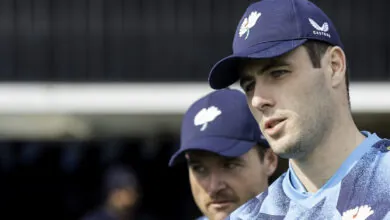Neither of these two counties had been officially formed when the first match between them took place in 1835. Sussex became a CCC in 1839 but the first official match against Yorkshire did not take place until 1873, that game being at Hove. Paul Dyson re-visits a match at the same venue which featured an outstanding performance.
August 20, 21, 22, 1896 at Hove: Yorkshire 407 (R Peel 106, FS Jackson 102, J Tunnicliffe 99); Sussex 191 (KS Ranjitsinhji 100, E Smith 5-42, GH Hirst 4-49) & 260-2 (KS Ranjitsinhji 125*, EH Killick 53*). Match drawn.
This match took place in the seventh season of the official County Championship; Yorkshire had won the title once and had finished in the top three in each of the last three seasons. Sussex, however had yet to finish higher than seventh and 1895 had seen it finish 11th (out of 14). Sussex were again in poor form in 1896; it had played 14 matches so far, had won only two and lost seven. In complete contrast Yorkshire had won 15 and lost three of its 24 games. (The counties arranged their own fixtures and played different numbers of matches – from 12 to 26.)
Lord Hawke won the toss for Yorkshire and decided to bat. His openers rewarded him with a stand of 143. FS Jackson was in his usual dazzling form and was the first to depart – for 102 – being bowled by the slow-medium of Tim Killick who had opened the bowling and would later open the batting as well! Jack Brown joined John Tunnicliffe (they were to become regular openers together) and the pair shared a half-century stand before three wickets fell for 13 runs to leave the score on 213 for four. Bobby Peel then came to the crease and another half-century stand ensued before Tunnicliffe was unfortunate to be dismissed one short of a century after his watchful and supportive innings. By close of play the visitors had reached 313 for five.
Hardly had the second day began than Yorkshire lost its sixth wicket without addition to the overnight total. Peel then shared another half-century stand with Ted Wainwright but there was little support from the tail until last-man, wicket-keeper Arthur Bairstow, arrived at the crease. Peel was 86 not out but Bairstow saw him through to his century and remained nought not out, Peel scoring all 20 runs in the tenth-wicket partnership to finish with 106, being run-out attempting to keep the strike. Sussex’s bowlers shared the wickets, three of them taking two each but Jock Hartley (leg-spin) took three. After what Wisden described as excellent batting the home side had slipped to 23 for two by close of play which had been brought forward by rain.
As on the second day, the final day began with a wicket before a run had been scored. Billy Newham then joined Kumar Ranjitsinhji and the pair transformed the innings with a partnership of 132. Newham’s contribution was only 37 but the Indian, who was not out, no score, overnight, was in such fine form that he put on a ‘marvellous exhibition’ of stroke-play. Unfortunately, the batting collapsed around him, six wickets falling for a mere 15 runs, but after he had departed for exactly 100, being caught off the fast-medium bowling of Ernest Smith, the last pair added 21 together. However, the deficit was 216 and Sussex were asked to follow on. Smith finished with five for 42 and George Hirst, who had taken two of the first three wickets to fall, four for 49.
The home side had no alternative but to play for a draw and it began well with a first-wicket stand of 61 followed by another half-century stand between CB Fry (42) and Ranjitsinhji. With the score on 137 for two it was now Killick’s turn to support Ranjitsinhji and he did this so effectively that the pair batted together throughout the rest of the day and shard an unbeaten stand of 123 Killick making 53 not out. By finishing on 125 not out Ranjitsinhji completed his second century of the match and, remarkably, all of his 225 runs had been scored on the third day. He was only the third batsman to score two centuries in a match against Yorkshire; WG Grace had performed the feat eight years earlier for Gloucestershire and Bill Storer for Derbyshire just three weeks earlier. No wonder that Ranjitsinhji had ‘caused the wildest excitement amongst the spectators’.
Sussex played three more matches after this game but won none of them thus finishing its 18-match campaign with just two wins and nine defeats. It finished bottom of the 14-team Championship table. Yorkshire, however, finished at the other end of the table thus winning its second title. It had won 16 and lost only three of its 26 matches and finished well ahead of Lancashire, Middlesex and Surrey who were by some distance the strongest counties.
Profiled player:
The bowler who did most to dismiss Sussex for its lowish first innings score and thus enable Lord Hawke to enforce the follow-on was Ernest Smith. As a ‘schoolmaster’ he was one of a breed of amateur cricketer who played for their counties only in late-July and August, a tradition which lasted until amateur status was abolished after the 1962 season.




